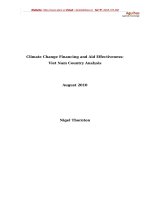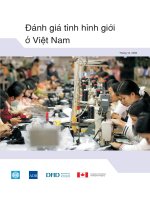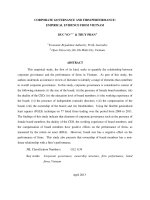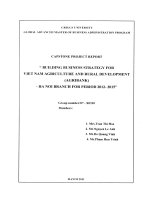VIET NAM COUNTRY AND PEOPLE
Bạn đang xem bản rút gọn của tài liệu. Xem và tải ngay bản đầy đủ của tài liệu tại đây (71.26 KB, 2 trang )
VIET NAM: COUNTRY AND PEOPLE
Geography and climate
Vietnam covers a total mainland area of 331,212 km2 and vast territorial water. Vietnam is a
strip land like a huge letter “S” (S-SHAPE COUNTRY), and lengthen 1.650 km from North Pole
to South Pole of Vietnam.
Length of country’s land boundaries is 4,639 km, bordered by China to the north (> 1,400km)
and sharing a frontier with both Cambodia (appropriately 2,100 km) and Laos (1.100 km) to the
west. Vietnam is located on the eastern Indochina Peninsula, and near the center of South East
Asia, and its coastline is 3,444 km long, it has ideal favorable conditions to develop in general
economy, in particular commerce and tourist.
Mountains and tropical forests account for 3/4 of the country's land area, but the flatlands make
up the most heavily populated portion of the country. The country’s two “rice bowls” lie in the
Red River delta in the North and the Mekong River delta in the South.
Broadly speaking, Vietnam has a tropical monsoon climate, with high humidity throughout the
year. In the north, has four distinct seasons including spring, summer, autumn and winter in the
North with two separate seasons: dry season and rainy season. Central Vietnam has severe
climate, and is frequent affected by natural disasters such as drought, flood. Annually, Vietnam
has approximately 1500-2000 hours of sunshine with the heat radiation over 100kcal / cm2 / year
and 100 days of rain with the average annual rainfall from 1,500 – 2,000 mm.
Population
According to statistics, Vietnam’ population is 84,156 thousand people (in 2006). Vietnam ranks
number 3 in Southeast Asia, 14 in the list of countries and territories on the world by population.
The population density is 254 people / km2 (2006). Average annual population growth rate is
1.32% (2002-2005).
The rapid population growth has put tremendous pressure on socioeconomic development of the
country, the protection of natural resources and improving the quality of life of every member of
society.
Now, due to increasing awareness of the impact of population on the development of the country
and welfare of the family, more people apply actively family planning. They believe that it
contributes to reduce the rate of annual population growth to below 1%.
Vietnam has an extremely unequal distribution of its population, high densities are in coastal
areas and plains and account about 75% of the population (Red River Delta is 1220 persons /
km2-2006). Midland and mountainous populated sparsely (Highlands is 89 people / km2,
northwest of 69 people / km2-2006)
The Vietnamese government recognizes 54 ethnic groups, of which the Viet (Kinh) is the largest;
ethnic Vietnamese account for 86.2 % of the nation's population, the rest of the ethnic minorities
scatters the majority of Vietnam's land. Approximately 60% of the population lives on
agriculture Vietnam and about half the population under 25 years old. Annually, Vietnam
population still increases an average of 1 million people. This is a potential and a great challenge
for Vietnam.
Natural resources
Vietnam has natural resource diversity, including forests, and sea minerals. Forest Vietnam is
considered to have high biological value with rich flora and fauna. Overall, Vietnam's forests
have about 800 species of trees, 60 species of bamboo and over 1500 species of herbs. Wildlife
is including 275 species of mammals, 826 birds, 100 amphibians, 180 reptiles. Many rare
animals of Vietnam are recorded in the Red Book.
Besides, Vietnam also has a great potential of energy resources such as oil, gas, coal and
hydroelectric power, Vietnamese is also rich in other minerals including iron ore, copper, gold,
precious stones, bauxite, tin, zinc, chromium, apatite, and building materials such as granite,
marble, clay, graphite. In addition to the resources of the sea and agricultural power are enriching
Vietnam's wealth of natural resources.









